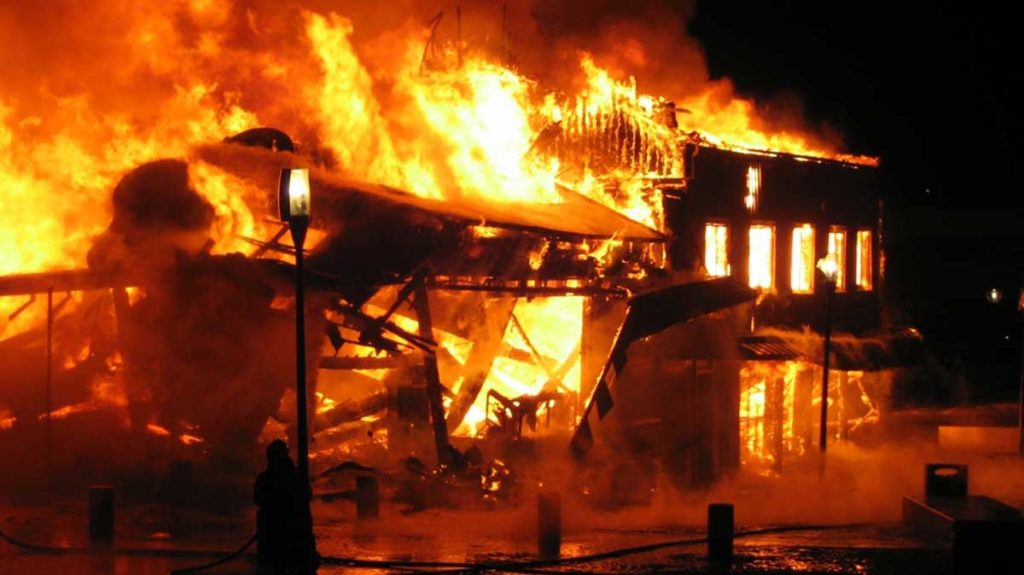Introduction
Arson is the crime of intentionally destroying or damaging property by fire. It is the largest single cause of fires attended by fire and rescue services in the UK. In 2022/23 arson accounted for over 50% of all recorded fires (109,623 of total 214,984 fires) in the UK with an estimated economic cost of £1.49bn. Many incidents are not however recorded and this figure could be greatly underestimated. During the same period, 181 deaths were recorded in England and Scotland as a result of deliberate fires. The demand on some fire and rescue services by arson diverts resources away from life risk incidents and preventive activities. Arson has been increasing in frequency since 2014/15. Most attacks are unplanned and opportunist in nature.

Risk Factors
The following common factors should be considered when evaluating the arson risk:
- Business/trade – Is the business a potential target for extremists, political activists or other groups?
- Location – What are the local crime and arson rates? Is there any recent history of problems in the area? Are the premises unattended outside business hours, overlooked, isolated and/ or secluded? Are there any nearby youth clubs, schools, pubs, nightclubs or similar venues attracting gatherings of people? Much of this information can be ascertained using Map View and elsewhere online. The Regional Surveyor is also a good source of local knowledge.
- Site access – Is the perimeter adequately secured against unauthorised entry?
- Security – How secure are the premises? Security needs to be commensurate with the perceived level of risk. Consider the building envelope, doors/windows/other openings, external lighting, electronic protections (intruder alarm and camera systems; are these remotely monitored?) and manned guarding/mobile patrols.
- Storage of combustibles – What fuel sources are available, particularly outside the property? Examples include waste materials/bins/skips, pallets, stock, flammable liquids/gases, combustible structures, vehicles and the like. Are these accessible or secure? Are they located close to buildings, to which any fire might spread?
- Employees, visitors and contractors – Is there anyone who may be disgruntled with the policyholder or have reason to target their business (for example, following redundancy or due to a dispute)?
- Unoccupancy – Vacant buildings are particularly vulnerable and can be an easy target for arsonists.
- Underwriters and Surveyors should at all times be mindful of any potential indicators of financial instability or poor moral hazard. Arson has obvious links to insurance fraud.
Prevention Measures
- External storage – Avoid storing combustibles externally, or alternatively secure these to prevent interference. Any external storage should be a minimum clear distance of 5 metres away from both buildings and the site perimeter (where practicable).
- Flammable liquids and gases should be locked in secure stores. External storage tanks should be fitted with valve locks or other security devices to prevent unauthorised usage.
- Provide good perimeter security to the site by means of adequate walls, fencing and gates.
- Install exterior security lighting.
- Provide a good standard of physical protection and ensure all doors, windows and other openings are secured when the premises are unattended.
- Consider installing electronic security (intruder alarm and/or CCTV cameras) systems with remote monitoring by an approved alarm receiving centre.
- Consider installing an automatic fire alarm system with remote monitoring by an approved alarm receiving centre.
- Vacant properties should be cleared of all combustibles both externally and internally and letter flaps sealed to prevent accumulations of junk mail. Inspections should be undertaken at maximum intervals of 7 days by a responsible authorised person. It may also be necessary to board up accessible doors and windows and/or install a temporary electronic security system.
- This subject is covered in more detail in the separate Unoccupied Property Protection toolbox talk.
- Clients should consider the arson risk and determine appropriate control measures as part of their wider fire risk assessment and review this periodically to ensure it remains relevant and up-to-date.
Technical Talks is our series of risk management articles, produced by our in-house team of portfolio underwriting, risk managers and surveyors, offering support and guidance for you and your clients in relation to everyday business solutions.